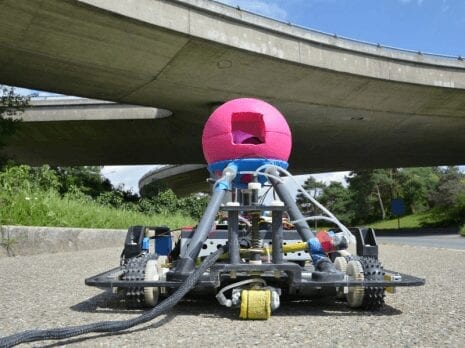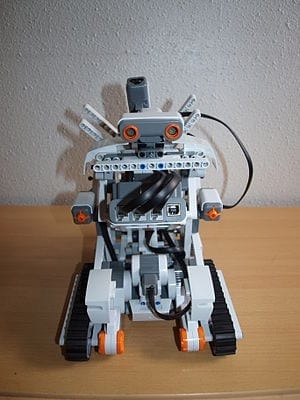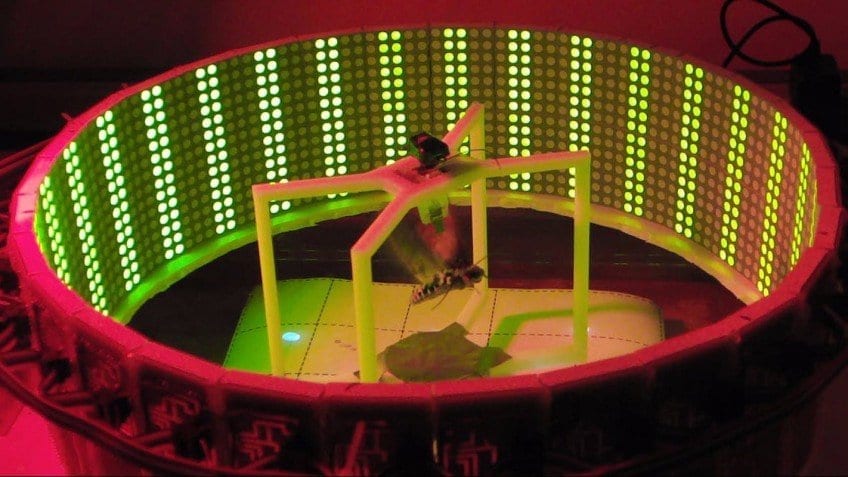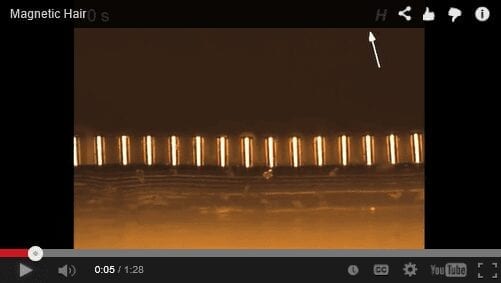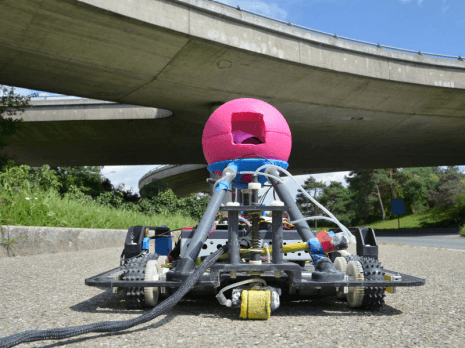
Bridges become an infrastructure problem as they get older, as de-icing salt and carbon dioxide gradually destroy the reinforced concrete. A new robot can now check the condition of these structures, even in places that people cannot reach.
We rely on Switzerland’s 3,500 motorway bridges – plus thousands more on cantonal roads – to carry us safely across valleys, streams, rivers and other roads. Most of these bridges have two factors in common: they are essential to Switzerland’s transport infrastructure and they are made of reinforced concrete. This material makes them safe and durable – until the onset of corrosion.
Corrosion jeopardises Swiss infrastructure
Corrosion occurs when chloride invades from de-icing salt and destroys the reinforcing steel inside concrete or when CO2 from the atmosphere lowers the concrete’s normally high pH. The damage becomes worse over time and is often visible only at a very advanced stage. In the long term, this can jeopardise the usability and safety of bridges and other supporting structures made of reinforced concrete. Furthermore, restoring these bridges is very expensive: the greater the damage caused by the corrosion, the more costly the repair work. “In addition, many bridges in Switzerland are already more than 50 years old, which makes corrosion increasingly problematic for Switzerland’s infrastructure,” explains Bernhard Elsener, professor at the Institute for Building Materials at ETH Zurich.
That is why Professor Elsener and a team of researchers developed the technology 25 years ago to identify corrosion at an early stage, attaching an electrode to a wheel and wheeling it across the surface of the reinforced concrete. The sensor measures the electric potential difference in the reinforced concrete – large differences mean that the reinforcement has already started to corrode in those areas. The data is transferred to a computer and then analysed.
The Latest on: Corrosion detection
[google_news title=”” keyword=”Corrosion detection” num_posts=”10″ blurb_length=”0″ show_thumb=”left”]
via Google News
The Latest on: Corrosion detection
- Flint's water had lead. The government lied about it. 10 years later, we need answers.on April 28, 2024 at 8:49 am
This article originally appeared on Detroit Free Press: Flint's water had lead. The government lied about it. 10 years later, we need answers.
- Saltwater Pool vs. Chlorine Pool Cost: Which Type of Pool Best Fits Your Budget?on April 26, 2024 at 10:07 am
Saltwater pools need a chlorine generator, corrosion inhibitors, and an additional pump ... it’s common for a homeowner to remedy many issues with one of the best pool home testing kits and the right ...
- 2024 Nissan Ariya: A Comprehensive Guide On Features, Specs, And Pricingon April 26, 2024 at 4:00 am
The Nissan Ariya only comes standard with a 120-volt Level One charging cable, but it has an official partnership with Wallbox. The 40 amp Pulsar Plus costs $649, but you can get the 48 amp unit for ...
- The EPA says lead in Flint's water is at acceptable levels. Residents still have concerns about its safety.on April 25, 2024 at 7:25 pm
It's been a decade since the Flint water crisis began. Residents told CBS News the scandal still weighs heavily on the city.
- Dozens march to Flint city hall as the water crisis turns 10 year oldon April 25, 2024 at 4:33 pm
Chanting “Clean water is what we demand,” “Water is a right” and “No justice, no peace,” dozens of people marched to Flint City Hall on Thursday to demand “justice and accountability” as the Flint ...
- The Best Jumper Cables of 2024on April 25, 2024 at 11:09 am
Jumper cables are a lifesaver when your car fails to start due to a weak or dead battery. Here are our top picks for a… The post The Best Jumper Cables of 2024 appeared first on GearJunkie.
- 10 years after it was triggered, Flint remembers the beginning of the water crisison April 25, 2024 at 7:39 am
Some played big public roles in the Flint water crisis. Some were so angry that they fought City Hall for the first time in their lives.
- 20 critical moments in the 10-year history of the Flint water crisison April 25, 2024 at 2:00 am
FLINT, MI -- It has been 10 years since the city of Flint switched its water source, triggering a monumental health and infrastructure crisis that’s still being dealt with today. Claims are still ...
- New stealthy submarine glider set for autonomous undersea missionson April 24, 2024 at 3:00 am
Northrop Grumman's Manta Ray uncrewed underwater vehicle aims to revolutionize undersea missions — it glides through the ocean without human assistance.
- Corrosion found in treated radioactive water tanks at Fukushima planton April 21, 2024 at 12:36 am
Corrosion has been found on the inside of tanks used to store treated radioactive water at the crippled Fukushima Daiichi nuclear power plant, its operator has revealed. Tokyo Electric Power Company ...
via Bing News







